On January 7, 1929, the "John F. Dille, Company", had started running a Sunday Newspaper Science Fiction Comic Strip. The strip was written by Philip Francis Nowlan and illustrated by Richard "Dick" Williams Calkins. Nowlan changed his main character's name from either "Anthony", or "Tony", to just a nickname, and "Buck Rodgers" was born.
Initially, Willian Randolph Hearst's, "King Features Syndicate", wanted to make a Sunday comic strip of Edgar Rice Burroughs, "John Carter of Mars", but the author wanted more than the other wanted to pay and the possible deal fell through. For those of my readers who might only think of Burroughs as the creator of "Lord Greystoke", aka: "Tarzan of the Apes". My article is "Before 'STAR WARS': There was Edgar Rice Burroughs" exploring space and time travel at:
https://www.bewaretheblog.com/2016/01/before-star-wars-there-was-edgar-rice.html
The Hearst company still wanted a share of the "Buck Rodgers", Sunday comic market, and the executives at "King Features" turned to one of their contract staff artists, Alexander "Alex" Gillespie Raymond. He was told to come up with a new comic strip to take down "Buck Rodgers". Raymond's strip would succeed beyond expectations, when launched on January 7, 1934.
From September 1932 through February 1933, in the magazine the "Blue Book", a science fiction story by authors Edwin Balmer and Philip Wylie first appeared entitled "When Worlds Collide". As the magazine's cover for September 1932 shows, that issue included the second installment of Edgar Rice Burroughs, "Tarzan and the Leopard Men".
Pertaining to the novel, "When Worlds Collide", according to authors Alfonso "Al" Williamson, and Peter Poplaski's, in their 1990, "Introduction to Alex Raymond", in "Flash Gordon: Mongo, the Planet of Doom", Princeton, Wisconsin, "Kitchen Sink Press", page 5:
The themes of an approaching planet threatening the Earth, and an athletic hero, his girlfriend, and a scientist traveling to the new planet by rocket, were used by writer Alex Raymond in his 1934 comic strip Flash Gordon.
The following is the actual first panel for the "Flash Gordon" comic strip drawn and written by Alex Raymond. According to the trade paper, "The Hollywood Reporter", March 31, 2020, the panel sold for $480,000. The complete article may be read at:
Don W. Moore was the ghost writer for Alex Raymond after the first story, and may have assisted on that one also. I looked high and low, but could not find a photo of Moore. When Austin Briggs took over illustrating "Flash Gordon", by first sharing the illustrations for the 21st Sunday series, "Triumph in Tropica", February 13, 1944 through August 13, 1944. Don W. Moore continued writing the illustrated panels for Austin Briggs through the 31st,"Flash Gordon", Sunday comic story, "Lost Land", ending on July 25, 1948.
The next collection, April 8, 1934, through November 8, 1934, was novelized under the title of "Flash Gordon and the Monsters of Mongo".
A Daily "Flash Gordon" comic strip illustrated by Austin Briggs, also ran from May 27, 1940 through June 3, 1944.

On April 30, 1912, Carl Laemme, above, was able to get a group of independent producers to merge into the "Universal Film Manufacturing Company". Laemme was elected President and the other board members included Mark Dintenfass, Charles O. Baumann, Adam Kessel, Pat Powers, William Swanson, Robert H. Cochrane, and Jules Brulatour. On May 20, 1912 "Nestor" became part of the new company and David Horsey joined the board.
Three years later, "Nestor", the first motion picture studio IN HOLLYWOOD was part of the first motion picture studio TO LEAVE HOLLYWOOD.
Carl Laemme had purchased 230 acres of converted farmland in another Spanish land grant area called the San Fernando Valley. His new movie studio was part of the community of Lankershim. Located just across the Cahuenga Pass, eventually called Cahuenga Boulevard, through the Hollywood Hills. In 1927 the name Lankershim was changed to North Hollywood.
The forerunner of "Universal Pictures" opened on March 15, 1915.
THINK, "Universal Pictures" in 1935, and there is no question that the studio's horror entires take center stage in my reader's minds with, "The Bride of Frankenstein", the "Werewolf of London", and possibly "The Raven", starring "KARLOFF", with Bela (Dracula) Lugosi. Move to 1936, and the year started off on January 20th, with that horror duo starring in "The Invisible Ray", and in May, Gloria Holden was the Lesbian vampire, known as "Dracula's Daughter".
However, overlooked by most fans of the studio are the westerns, crime thrillers, and even musicals. Such as the excellent version of the Jerome Kern and Oscar Hamerstein II musical, 1936's, "Show Boat", directed by "Universal's" horror master, James Whale.
Also not thought of, are the studio's 137-Cliff-Hanger's, aka: Chapter Serials, starting in 1914 with "Lucille, Girl of Mystery", directed by Francis Ford, the older brother of director John Ford, and ending with the 1946 science fiction, "The Mysterious Mr. M".
Which brings me to:
FLASH GORDON Chapter One released on April 6, 1936
There were two directors:
Frederick Stephani was the credited director. This was the first of his eleven credits as a director. Technically they should only be ten, because listed is the condensed version of this serial. Also, he didn't direct again until 1952, and on television for nine different programs through 1961.
Ray Taylor was the uncredited director. Between 1926 and 1956, Taylor directed 156-movies, mostly "B" westerns.
There were two "Universal Pictures" special effects creators:
Ed Keyes did the "Special Mechanical Effects" and was the uncredited "Prop Master" on 1931's, "Frankenstein".
Ken Strickfaden was uncredited for the serial's "Special Electrical Properties". In the past for "Universal Pictures" he did the same for both 1931's, "Frankenstein", and 1935's, "Bride of Frankenstein". For "Metro-Goldwyn-Mayer", he was the uncredited "Special Effects Electrician" on 1932's, "Mask of Fu Manchu".
The Five Main Roles from the Comic Strip Based Upon the Official Cast Listing:
Larry "Buster" Crabbe, portrayed "Flash Gordon" with dyed blonde hair to look like the comic strip character. He was born Clarence Linden Crabbe II, and his parent's nicknamed him "Buster". As a Swimmer, Buster Crabbe won first the Bronze Medal at the 1928 "Summer Olympics" in Amsterdam, Netherlands, and 4-years-later, he won his second medal, the Gold, in the 1932, "Summer Olympics" in Los Angeles, California. In 1933, Buster Crabbe appeared first as "Kapa the Lion Man", in the somewhat Edgar Rice Burrough's rip-off of a white boy raised by lions. Then two-films later, he starred in "Tarzan the Fearless", a 12-Chapter serial based upon Burrough's character that was supposed to have been played by the author's son-in-law. Then in 1934, "Paramount Pictures" decided to change their contracted actor's name and he became Larry "Buster" Crabbe. My article is "Tarzan, Flash Gordon, Buck Rodgers, Billy the Kid and LARRY 'BUSTER' CRABBE!" at:
https://www.bewaretheblog.com/2020/06/tarzan-flash-gordon-buck-rodgers-billy.html
Roy Barcroft portrayed a "Throne Guard", in his 3rd-on-screen appearance. That's Barcroft on the left, below. The title "Space Soldiers" was used when the 1936 serial was syndicated to 1950's television.
Barcroft became one of predominant "B"cowboy villains. He also became one of the top serial space villains with the title role in 1945's, "The Purple Monster Strikes", and portraying "Retik", in 1952's, "Radar Men from the Moon" fighting "Commando Cody". However, his bad-guy-image changed drastically, when Roy Barcroft became "Colonel Logan", the owner of the "Triple R Boys Ranch", on "The Mickey Mouse Club's", "Spin and Marty". My article is "Roy Barcroft: The Purple Monster Strikes the Mickey Mouse Club" at:
https://www.bewaretheblog.com/2024/10/roy-barcroft-purple-monster-strikes.html
No Human Force can stop it!
"Professor Gordon" agrees that:
Soon the Earth will be smashed to atoms!
"Hensey" now adds that he has some faith and hope in a "Dr. Zarkov". Whom "Gordon" counters by saying that scientist is absolutely "Mad!"
Next, the audience sees out take newsreel footage of actual panic and disasters from countries around the world. All being substituted for the disasters that the unknown planet is causing on the Earth.
As everything points to the end of the world, "Professor Gordon" is handed a telegram by the unidentified actor, and tells the other two men:
It's from my son, Flash! He gave up his polo game just in time to catch the trans-continental plane!
Adding that "Flash" wishes to be with his father and "Professor Hensley".
Switch to the plane in flight, the two Professors are now out of the next 12-Chapters, as the audience sees "Flash Gordon" eying a beautiful blonde. The plane enters a weird atmospheric disturbance that is described as a meteor shower. Everyone in the plane's passenger section are frightened, except our hero, "Flash". The co-pilot enters the passenger cabin and he explains that under everyone's seat is a parachute. Adding that they were ordered to put one on every seat, something apparently, they never have done before. The passenger's now have two choices, one is to stay with the plane and the pilot will attempt to land it, or they can use the parachute's and jump out of the plane into the disturbance. Every passenger, but two, put on those parachutes, that they never used before, and all jump out of the airplane.
Inside the plane, the blonde woman is still hesitating over jumping out of the plane, time is running out, and "Flash" in a flash, grabs the blonde's parachute ,and the two, together, jump out of the plane.
As the two, with "Flash" working the young woman's parachute, near the ground, the airplane is hit by a meteor and explodes. What happened to the other passengers is dropped from the story, and "Flash" and the young woman passenger, unharmed, find that they're standing near a rocket ship. "Flash" makes a flippant statement:
Some fool trying to fly to Mars?
Next, a beared man approaches with a pistol aimed at "Flash", but drops his aim. When he learns the other man's name and asks if he's the son of "Professor Gordon"? Confirmed, the audience, "Flash" and the beared man, learn the young woman is "Dale Arden".
"Flash" mentally puts the rocket ship together with the beared builder of the rocket ship and concludes that he is the scientist his father called mad, "Dr. Zarkov". As I mentioned, not Alex Raymond's "Dr. Hans Zarkov", but the screenplay writers, "Dr. Alexis Zarkov".
"Zarkov", the not so mad, mad-scientist, reveals that he believes the run-away planet is not so run-away, but also radioactive. Stating, if he could get there, he might be able to change its course, or at least that's his theory. However, his assistant was fine until he realized he was expected to go to the rogue planet in the scientist's not completed rocket ship and left "Dr. Zarkov".
Researching this article, I've found several reviewers who questioned the idea of a planet being radioactive. I would mention that radioactivity was accidentally discovered in 1896 by French physicist Henri Becquerel and that Herbert George "H. G." Wells wrote his novel about an atomic war, "The World Set Free", in 1913, and published it in 1914. This is science fiction, so why not a radioactive planet?
However, "Zarkov" wants "Flash" to accompany him on his trip to the rogue planet. Our hero agrees, but only once he has taken "Dale Arden" to a safe place. However, "Zarkov" points out that, if he fails, there will be no safe place on Earth for her. "Dale" tells both men that she's going to the planet on the rocket ship.
As the rocket ship precedes, "Dale" starts to choke, and "Dr. Zarkov" apologizes for forgetting to turn the oxygen on. The three Earth explores are nearing the rogue planet, when"Flash" and "Dale" are surprised to hear "Dr. Zarkov" tell them:
We've just passed the Death Zone!
Apparently something the scientist feared, but forgot to tell his two passengers about. The "Death Zone" is a radiation field between the Earth and the rogue planet. "Zarkov" manages to land his rocket ship on the rogue planet.
Next, "Zarkov", "Flash", and "Dale" set foot on the rogue planet.
Wait, the above photo looks like "Dr. Zarkov's" rocket ship, but the three people outside don't look like "Flash", "Dale", or "Zarkov". That's because my reader is looking at a scene from the forgotten fantasy musical motion picture, 1930's, "Just Imagine". That takes a look at 1980's "New York City", in a motion picture from the 1920's, 1930's, musical composers and Broadway musical writers, Buddy G. DeSylva, Lew Brown, and Ray Henderson. Who, among other songs, wrote "The Birth of the Blues", "I'm Sitting On Top of the World", "April Showers", "Bye Bye Blackbird", and "Five Foot Two, Eyes of Blue (Has Anybody Seen My Gal)". The motion picture starred a pre-"Jane", from 1932's, "Tarzan the Ape Man", Maureen O'Sullivan.
"Just Imagine" was a "Fox Film Production", and the electrical effects were by Ken Strickfaden, which he would use again, as I've mentioned, for "Universal Pictures", 1931, "Frankenstein".
The models and glass screen projections in "Just Imagine", were by four uncredited technicians. Two were the same team that was three-years away from bringing "King Kong" to the motion picture screen, stop-motion-animator Willis O'Brien, and model builder, Marcel Delgado. The other two were set designer, Stephen Goosson, and special effects designer and cinematographer, Ralph Hammeras.
Returning to "Flash Gordon":
Outside of their rocket ship, the three Earth visitors are met with local dinosaur life.
A flying machine appears, shoots and kills the dinosaurs, and then lands. Out of the other ship comes three men (?), one is "Officer Torch", portrayed by Earl Askam, one of the two "Robots", we know was portrayed by Glenn Strange, the other "Robot" was portrayed by Fred Kohler, Jr.. Which is which, is up to my reader to decide.
"Officer Torch" informs the three Earth visitors that:
You are to be taken to Ming, Emperor of the Universe.
"Flash" punches "Torch", and would go further, but "Zarkov" stops him. He knows the three must meet and speak to "Ming" to stop his planet from colliding with Earth.
The Earth people are taken to "Emperor Ming's" throne room. Where "Ming" asks "Officer Torch" if there was any resistance and his reply indicates "Flash". "Dr. Zarkov" asks "Ming" to help stop the out of control, now named, planet "Mongo". "Ming" replies that "Mongo" is not out of control, but under his direct control and he's going to destroy the Earth in his own way. Learning that "Zarkov" designed and built their rocket ship, "Ming" orders that the scientist be taken to "His Own Laboratory" and to be given anything the Earth scientist requires without question, except for one thing, his freedom!
"Ming" orders that the Earth man be taken to the arena.
"Flash" fights the guards taking him away, but "Emperor Ming" thinks of the sport the Earth man will provide. He then turns back to "Dale", however, "Ming's" daughter demands that should "Flash"survive the arena, he should be given to her. "Ming" figuring the Earth man will not survive, agrees.
"Flash" now meets wrestlers with fangs in a large arena area, but to the disappointment of "Ming the Merciless", dispatches his three opponents.
"Ming", instead of giving "Flash" to his daughter as promised, orders that he be taken to the pit. "Aura" reminds her father that under Mongo's laws, "Flash Gordon", as the winner of the match, must be set free, but "Ming" reminds "Aura" that he is the law.
A small group of guards come to escort "Flash Gordon" to the pit, but in another struggle. "Flash" causes one of the guards to drop his raygun. "Aura" picks up the raygun, and fires it at a the guard who dropped it.
"Aura" does hit the guard and as he falls to the ground. His hand brings down the lever opening the pit and both the Earth man and the Emperor's daughter fall into it. As the audience is told to- - - -
Within the storyline, starting with Chapter 2, are three group's of advisories for "Flash Gordon". That depending upon their leader's mood at time, are either loyal to "Ming", or wanting him dead. "Flash" must unite them against "Emperor Ming". However, each has their own quarrels with the others, and that is a problem that must be overcome.
The Main Character of Each of These Three Group's are:
"Prince Thun", portrayed by James Pierce, the son of the leader of the "Lion Men", and "Flash's" closest friend on Mongo. He appears in Chapter's 2 through 9, 12 and 13.
"Prince Barin", portrayed by Richard Alexander, and technically, the "Prince" is a "King", over the area of Mongo known as "Arboria". He's in love with "Ming's" daughter "Aura", and she is with him, most of the time. "Barin" appears in Chapter's 5 through 13.
"King Vultan", portrayed by Jack "Tiny" Lipson. He got the nickname "Tiny" because of his height and weight. "King Vultan" is the leader of the "Hawkmen", who do fly, and live in "Ming's" prison city, "Sky City", floating in the air over Mongo. "King Vultan" appears in Chapter's 5 through 13.
Chapter One: "Planet of Peril" runs 21-minutes and 11-seconds, and the entire 13-Chapters are 240-minutes and 5-seconds.
The website, "Internet Archive", as of this writing, has the entire colorized, 1936, "Flash Gordon" serial for my readers enjoyment at:
https://archive.org/details/flash-gordon-episode-1-1936-colorized-serial-720p-hd
It was this first "Flash Gordon" serial, that inspired composer Richard O'Brien to create the song lyric about Buster Crabbe's costume:
And Flash Gordon was there in silver underwear
for his 1973 musical "The Rocky Horror Picture Show". My article is "Science Fiction Double Feature: How Many Movie References are In It?" to song to at:
https://www.bewaretheblog.com/2015/02/science-fiction-double-feature-how-many.html
Above, not quite "Silver Underwear", but you get Richard O'Brien's lyrical point.
In December 1936, the first, last, and only issue of a proposed magazine, "Flash Gordon's Strange Adventures Magazine" was published, promising a second issue to come.
The next motion picture serial entry brought a mystery that remains unsolved through this writing:
FLASH GORDON'S TRIP TO MARS Chapter One released on March 21, 1938
All 4-screenplay-writers from the 1936 serial, received credit for the "Archival Footage" used in the new production.
However, for the new screenplay, there were 4-new screenplay writers.
Ray Trampe started writing with the 1935 serial, "The Adventures of Rex and Rinty", "Rex" was a horse, and "Rinty", was Rin-Tin-Tin-Junior. He also co-wrote the 1937 serial, "Jungle Jim", based upon another Sunday comic strip by Alex Raymond, and the Jean Rodgers serial, 1937's, "Secret Agent X-9", also based upon a Raymond comic strip.
Norman S. Hall co-wrote the 1933 serial, "The Three Musketeers", moving French author Alexander Dumas's story to the Arabian Desert. The serial starred a young John Wayne, and featured Creighton Chaney, before he became Lon Chaney, Jr. Hall had co-written both "Jungle Jim", and "Secret Agent X-9".
Wyndham Gittens co-wrote the same serials as Norman S. Hall, and this was the 4th-writer, Herbert Dalmas's first screenplay.
The working screenplay carried the title, "Rocket Ship", read on about that title's confusion.
Larry "Buster" Crabbe portrayed "Flash Gordon", still with his dyed blonde hair. Just before this release, Larry Crabbe had 4th-billing in the action, adventure, crime, romance, 1938's, "Tip-Off Girls", starring the forgotten "B"actress, Mary Carlisle, and Lloyd Nolan. Crabbe followed this serial with 1938's, "Hunted Men", starring Mary Carlisle and Lloyd Nolan once more. In this picture, Larry had 6th-billing before a new actor named Anthony Quinn.
Jean Rodgers portrayed "Dale Arden", without dying her brunette hair. Rodgers followed this motion picture with 7th-billing in the Gloria Stuart and Michael Whelan, 1938, film-noir murder romance, "Time Out for Murder".
Note Above: "Dale Arden" is now wearing a long dress, as is Beatrice Roberts, see below, and the other female characters. Also, sorry Richard O'Brien, but "Flash Gordon" is no longer in "Silver Underwear". Joseph Breen, spoke for the "Hayes Office" to protect the morality of American's, and he had to approve all costume's. Below, is an original drawing by Alex Raymond, with dialogue by Don W. Moore, for the Sunday comic strip, the novel, and screenplay were based upon. Imagine attempting to get such a scene past Breen.
For my reader wandering about the moves of Joseph Breen and others. The following link takes them to my article "CENSORSHIP Protecting (?) Protecting America's Morality in Motion Pictures: 1923 to 1973" uncensored at:
https://www.bewaretheblog.com/2017/06/censorship-protecting-americas-morality.html
Charles Middleton portrayed "Emperor Ming". "Ming" is as evil, if not more, than he was in the first serial, but he is also more manipulative and appears to be romancing "Queen Azura". Middleton was last seen with the uncredited role of "an Officer", in the Bette Davis, Henry Fonda, and George Brent, 1938, "Jezebel". He followed this serial with the uncredited role of a "Politician", in the 10-minute, biographical short, "Joaquin Murrieta".
Frank Shannon portrayed "Dr. Alexis Zarkov". Who was still "Dr. Hans Zarkov" in the Raymond and Moore comic strip. Shannon had just been seen in the uncredited role of a "Policeman with a Warrant", in the Dick Foran drama, 1938's, "Over the Wall". He followed this serial in the uncredited role of the "Man on Crutches"in the Ronald Reagan crime drama, 1938's, "Accidents Will Happen".
Beatrice Roberts portrayed "Queen Azura". Roberts had just been seen in the Bruce Cabot single starring motion picture, with 2nd-billing, 1937's, "Love Takes Flight". Roberts followed this serial with 45-uncredited roles including 1942's, Edgar Allan Poe's, "The Mystery of Marie Roget", and both 1943's, "Frankenstein Meets the Wolfman", and "The Phantom of the Opera".
Three Important Other Characters:
Donald Kerr portrayed aggressive newspaper reporter "Happy Hapgood". Kerr was the 1930's style comic relief, who sneaks onto "Dr. Zarkov's" rocket ship. He was a character actor that started on-screen with 12th-billing in 1933's, "From Hell to Heaven", starring Carole Lombard and Jack Oakie. He ended his acting career, according to the "IMDb" website with his 558th-role, in 1966's, "Made in Paris", starring Ann-Margaret, Louis Jourdan, and Richard Crenna, portraying "An Old Man".
C. Montague Shaw portrayed the "King of the Clay People". Australian actor Charles Montague Discombe Sparrow was always cast in British character roles. In 1936, Shaw portrayed inventor "Professor Norton", in "Undersea Kingdom", starring "Crash" Corrigan.
Below, C. Montague Shaw without make-up.
Richard Alexander, was the only other actual actor from the first serial, portraying "Prince Barin".
While, Alexander also appears on some of the "Archival Footage" from 1936, those who only appear in that footage, include Priscilla Lawson portraying "Princess Aura", Jack "Tiny" Lipson portraying "King Vultan", and Glenn Strange portraying one of "Ming's Soldiers".
1938's, "Flash Gordon's Trip to Mars" opens with "Chapter One: New Worlds to Conquer", and the audience sees "Dr. Zarkov's" rocket ship with "Flash" and "Dale" returning to the Earth after stopping "Ming" in the previous 1936 serial, "Flash Gordon". The three return as "Earth's Mightiest Heroes" of the 1930's. The opening credits first show "Larry (Buster) Crabbe" as "Flash Gordon", Jean Rodgers as "Dale Arden", Charles Middleton as "Ming the Merciless", and most importantly, Beatrice Roberts as "AZURA, QUEEN OF MAGIC". Who will use her "Magic" on "Flash" to make him forget "Dale" and "Zarkov", and love only her.
18-minutes and 32-seconds into "New Worlds to Conquer", "Dr. Zarkov" admits he made "a terrible mistake", that the deadly "Nitron Ray" isn't coming from Mongo, but Mars. Alex Raymond had meteor's being guided from Mongo, not "Mars", and there wasn't some form of ray in the comic strip. However, must importantly, is until those words are spoken by "Zarkov", there has been no mention of Mars. The set's and clothing look exactly like those in the 1936 "Flash Gordon" serial on Mongo with very slight variations.
The following link will take my reader, as of this writing, to "Chapter One". Which also asks the viewer to answer the unmentioned question:
Why is "Dale Arden" now a brunette in a long dress?
https://www.youtube.com/watch?v=uFjYJSPdVxA
THE MYSTERY OR QUESTION OF HOW MONGO BECAME MARS:
As I write these words, it appears that there still hasn't been found any documentation to explain why the "Planet Mongo" became the "Planet Mars" for this serial. All we seem to have are theories and not factual written documentation to refer too. The following are two of those theories and some events that happened at the time of writing the screenplay and releasing the serial that may have had some influence on the name change, or the actual screenplay.
The Source Material:
The major credited source for the serial's screenplay was the "Whitman Publishing Company's", 1936 novelization of, "Flash Gordon and the Witch Queen of Mongo". Which was based upon the comic strip illustrations by Alex Raymond, and the dialogue by Don W. Moore, originally published between April 21, 1935 and October 13, 1935. Neither the original comic strip, nor the novelization, mention the "Planet Mars".
If you should go to the website, "Goodreads", at:
https://www.goodreads.com/book/show/4379563-the-witch-queen-of-mongo and you will read the following description of the novel version of "Flash Gordon and the Witch Queen of Mongo".
Victimized by a psychic teenage prankster, Flash Gordon, Dale Arden, and Dr. Zarkov find themselves instantly transported to the planet Mongo, where Flash is captured and drugged by the ravishing witch Queen Azura and her evil cohort -- none other than Ming the Merciless, Jr!
First, there is no "Psychic Teenage Prankster" in Alex Raymond's original comic strip, the 1936 novelization, or for that matter, the 1938 serial, "Flash Gordon's Trip to Mars".
Second, "Ming the Merciless, Jr", didn't appear until 1956, 20-years after the "Whitman Publishing Company" novelization. "Junior's" appearance was in the Daily comic strip series, "Return to Mongo", by artist Dan Barry, that ran from January 2, 1956 through March 24, 1956.
So, is the "Goodreads" teaser wrong? No, but it's not about the comic strip, or the "Whitman" publication. In 1974, "Avon Books", published a novelization of their own, with the misleading tag line:
Alex Raymond's Original Story
Which doesn't say it was "written by Alex Raymond".
The "Avon Books" novelization, with apparent story updating, was written by "Ghost Writer", Carson Bingham. Who, among other science fiction, wrote the novelization of the 1961, British motion picture, "Gorgo". It should be noted that at this time, "Avon Books", released a series of supposedly Alex Raymond written novels, but were ghost written by either Carson Bingham, Ron Goulart, and Bruce Cassidy, all three using the pen name of "Con Steffanson".
Returning to the actual, 1936, "BIG little Book" version of the Alex Raymond and Don W. Moore "Sunday Comic Strip". My reader finds that the book contains an expanded storyline, by a still unknown "Ghost Writer". Which was a standard procedure for the "Whitman Book Publishing Company's". Found on the "Trustpilot"website is:
https://www.trustpilot.com/review/whitmanbookpublishing.com
Whitman Book Publishing is a comprehensive book publishing company that specializes in transforming authors' ideas into professionally crafted publications. Their services encompass ghostwriting, editing, formatting, cover design, and global distribution, catering to a diverse range of genres and author needs. By offering tailored solutions, Whitman Book Publishing aims to support authors at every stage of the publishing process, ensuring their stories reach the intended audience effectively.
Above, Note the line, under Alex Raymond's name reading:
Based on the Famous Adventure Strip
It does not, however, say who actually wrote this book.
What the "Whitman Publishing Co." did, was to select panel's from the Raymond and Moore comic strip to help illustrate their authorized expanded story. Which "Universal Pictures" used for the screenplay.October 31, 1938:
The following comes from the website "Fandom:Flash Gordon" at:
https://flashgordon.fandom.com/wiki/Flash_Gordon%27s_Trip_to_Mars
A long-standing myth suggests that this serial was originally intended to be set, like the first, on the planet Mongo, but that the idea was changed at the last minute following the extraordinary reaction to Orson Welles' infamous 1938 War of the Worlds radio broadcast, which reportedly terrified some listeners into thinking Earth really was being invaded by creatures from the planet Mars. However, the Welles broadcast did not occur until Halloween night, several months after the release of Flash Gordon's Trip to Mars. It is likely that Mars was chosen simply to highlight the fact that this was a different story to the first adventure, and not some simple re-release of the first serial under a different title.
Consider that until that 18-minute and 32-second point of the 20-minute and 21-second, "Chapter One: New Worlds to Conqueror", the name "MARS" wasn't mentioned, but "Mongo" had been. As presented in that "Chapter", it does give the appearance of a last minute screenplay change, or was it dubbed in at a later time?
The Orson Welles story has become "Mythic", but was that the real reason for the title modification? There were other possibilities that have been forgotten. However, let me first speak to that broadcast by "The Mercury Theatre of the Air".
The obvious point, as mentioned in the above quote, against the broadcast being the source for the name change of the serial's planet from "Mongo" to "Mars", are the two date's.
I've indicated that "Chapter One: New Worlds to Conquer", was first shown on March 21, 1938. While, the radio broadcast that caused panic in Grovers Mill, New Jersey, was 8-months-later, on Halloween, October 31, 1938. Completely eliminating any possibility of the original release and the Orson Welles broadcast being related.
Above, George Orson Welles, leading his "Mercury Theatre of the Air".
I couldn't locates the dates, but we know that Orson Welles had been speaking about doing the broadcast weeks before it went on air, but weeks are not months. Also, time would have previously been needed to get the rights to H. G. Wells's, "War of the Worlds". Along with the time required to write the broadcast and rehearse. Even if this was all going on simultaneously, that still wouldn't have been close to when "Flash Gordon's Trip to Mars" would have been filmed. Sometime around the end of January and the start of February, 1938, or for that matter, the screenplay originally being written and approved by Joseph Breen of "The Hayes Office".
WHAT IS FACT, is that the "Universal Pictures" executives, rushed the serial to the studio film editors on November 1st, and released a 68-minute, feature length version, in the United States, on November 7, 1938. Documented by the "IMDb" website at:
https://www.imdb.com/title/tt0030423/releaseinfo/?ref_=tt_ov_rdat
The title for the "feature length version" of the serial, "Flash Gordon's Trip to Mars"was, "Mars Attacks the World". The studio was "NOW" playing off of the worldwide publicity being generated by "The Mercury Theatre of the Air's" broadcast of the H. G. Wells story.
There can be little doubt that the issuing of 1938's, "Mars Attacks the World", SEVEN-DAYS after the Orson Welles radio program, was the real source of the "Mythic" connection with him. Yet, that does not explain the planet's name change from the Alex Raymond comic strip and the source novelization.
However, don't breathe easily now, because according to the "Turner Classic Movies" website at:
https://www.tcm.com/tcmdb/title/75122/rocket-ship/#notes
Although various modern sources credit the 1936, 13-chapter serial Flash Gordon as the source for the feature length film Rocket Ship, Universal legal files reveal that Rocket Ship was a feature-length version adapted from the second serial, Flash Gordon's Trip to Mars, made in 1938. Rocket Ship was tentatively set for an April 1938 release, however, no official release date can be found in contemporary records, and the film was neither reviewed nor copyrighted. A credit sheet, dated April 18, 1938, that is contained in the copyright records for Mars Attacks the World, a feature compilation of footage from both Flash Gordon and Flash Gordon's Trip to Mars, notes that its title was originally Rocket Ship. Later, scenes from the feature Rocket Ship appeared in Mars Attacks the World.
Adding even more confusion, once again, is from the website, "IMDb", about the movie "Rocket Ship" :
https://www.imdb.com/title/tt0027624/releaseinfo/?ref_=tt_ov_rdat
That website indicates a release date of March 5, 1938, but refers to the feature length version of the 1936, "Flash Gordon" serial. According to Roy Kennard in his "Science Fiction Serials: A Critical Filmography of the 31 Cliff Hangers", published in October 1998. The March 5, 1938 date was for European release only, and that the film wasn't released in the United States until 1949.
Then we have the following two posters:
Above, a poster for "Rocket Ship", with the 1936 serial's cast. Below, a poster for "Rocket Ship", with the 1938 serial cast.
If I may, let me return to the actual screenplay and "Dr. Zarkov's" mistake in "Chapter One". I bring my reader to the title on the "Lobby Card", below, for "Chapter Seven", of "Flash Gordon's Trip to Mars", entitled, "THE PRISONER OF MONGO".
From "Dr. Zarkov's" rocket ship crashing at the beginning of "Chapter Two", "The Living Death" into "Chapter Seven", the audience is told the events are taking place on "Mars". So, was there a slip up, or as previously mentioned by the website "Fandom:Flash Gordon", a last minute change to the name of the planet, but not as that site implied?
In "The Prisoner of Mongo" at:
https://www.youtube.com/watch?v=1JC6FbQC10c&list=PLq-FIf1AmwbDmaE-Ybuc3WfEYnuth-Z6l&index=7
"Flash", "Dale", Zarkov", and "Happy" become prisoners of the Martian "Tree Man", who work for "Ming". The only time "Mongo" is mentioned, is when another prisoner, "Prince Barin", appears and the "Prince's" home planet is mentioned in greeting, before the five escape.
Is it no wonder that reviewers and motion picture historian's are confused?
Theories:
In the February 1912 issue of "All-Story" magazine, was the first chapter of what would become, "The Princess of Mars", "Under the Moons of Mars", by writer Norman Bean, the pen name of Edgar Rice Burroughs.
This "Chapter" introduced the United States to "John Carter", an ex-Virginia "Confederate Soldier", who in a cave in Arizona finds himself going through a gateway to the planet Mars. In 1917, the hardbound edition of Burroughs "A Princes of Mars", the complete story that started with, "Under the Moons of Mars", was released.
Between 1912 and 1938, 9 of the 11-books about "John Carter of Mars", that were all written by Edgar Rice Burroughs, were released and did stir an interest in the "Red Planet" not just in the United States.
The following paragraph comes from my article "Animator BOB CLAMPETT: Sea Sick Sea Serpents, a Tweety Bird and Introducing Man Eating Lions" at:
https://www.bewaretheblog.com/2021/05/animator-bob-clampett-sea-sick-sea.html
Back in 1936, Bob Clampett started working on the first animated cartoon of a proposed series based upon Edgar Rice Burrough's character "John Carter of Mars". Test footage was made, Clambett appeared ready to move to "Metro-Goldwyn-Mayer" to make the series, but it all fell through. Apparently, the "Marketing Agent" in the mid-west found that people in that area could not understand the concept of a Civil War vet ending up on Mars. However, could he do "Tarzan of the Apes"?
There is an article on the proposed animated series on the website "ERDzine" at:
Bob Clampett's idea to make a feature length animated film of "Princess of Mars" went back to 1931. When the animator first approached Edgar Rice Burroughs. The actual project started to come to fruition at the same time "Universal Pictures" released Alex Raymond's "Flash Gordon". Apparently the "Hollywood"trade papers mentioned the "John Carter of Mars" project, adding that Clampett was working on animating test footage.
Had the feature length animated motion picture been made, Bob Clampett's "John Carter of Mars", would have beaten out, Walt Disney's, 1937, "Snow White and the Seven Dwarfs", as the first full-length animated feature film.
The point here was that "Universal Pictures" was planning a sequel to "Flash Gordon" and a film set on "Mars" was being talked about in the trade papers by two major studios, "Warner Brothers", where Bob Clampett worked, and "Metro-Goldwyn-Mayer", where he planned to make "John Carter of Mars". Yes, this doesn't prove anything, but does present the concept of the rival studio, "Universal Pictures", picking up the idea of a Martian storyline and beating "MGM" to the motion picture screen with a serial starting actual filming. It would have been easy to change "Mongo" to "Mars".
Also, just published and becoming best sellers were two science fiction novels that any of the four screenplay writers might have read for ideas. These were 1937's, "Planet Plane" aka: "Stowaway to Mars", by John Beynon aka: John Wyndham, and C. S. Lewis's, "Out of the Silent Planet", set on Mars, about a man taken on board a space craft.
Adding to these two newsworthy, but unrelated events about Mars. Which might have influenced one of the serial's writer. Is that in the screenplay "Ming" was using the "Nitron Ray" to destroy the Earth's atmosphere.
A little reality vs a science fiction screenplay took place in January of 1938. There was an actual worldwide event effecting the Earth's atmosphere.
From January 16, 1938 through January 26, 1938, was an event that might have changed Alex Raymond's controlled meteor's into a "Nitron Ray". The event was a rare geomagnetic storm that Europe had not seen since 1709, and "The America's", since 1888. What added to the unimagined power of this storm were three prophecies that three children, pictured below, claimed to have been given to them by the "Virgin Mary". Their three meetings with the "Virgin Mary" took place between, May 13, 1917 and October 13, 1917, in Fatima, Portugal.
At the time of the geomagnetic storm, a very large number of Roman Catholic's from around the world, believed that one of the prophecies was coming true. As the storm fit the sign that was to be seen, predicting an even more terrible War than anyone country had yet experienced.
Was this geomagnetic storm the basis for "Ming's Nitron Ray"?
Maybe yes! Maybe no!
However, on September 1, 1939, Nazi Germany invaded Poland, and the Second World War began.
I've given my reader a combination of facts and theories about the title chosen by "Universal Pictures"for the sequel to their 1936 serial. However, except for what is mentioned in the above quotation from "Turner Classic Movies". There still appears to be no documentation explaining the decision to move the 1938 serial from "Mongo" to "Mars".
For my reader who wants to go to "Mars" with "Flash", the following link, at the time of this writing, will take you to the complete, 1938, "Flash Gordon's Trip to Mars" at:
https://www.youtube.com/playlist?list=PLq-FIf1AmwbDmaE-Ybuc3WfEYnuth-Z6l
For all the debate, that I admit to being part of, over how "Mongo" became "Mars"! "Flash Gordon's Trip to Mars" is considered the best of the three Cliff-Hanging Serials starring Larry "Buster" Crabbe as Alex Raymond's interplanetary hero. The third and final "Universal Pictures" serial is:
FLASH GORDON CONQUERS THE UNIVERSE released April 9, 1940

Larry "Buster" Crabbe portrayed Alex Raymond's "Flash Gordon" for his third and final time. Between "Flash Gordon's Trip to Mars" and this serial, Crabbe appeared as his character's own competition, in the 1939 serial, of Philip Francis Nowlan's "Buck Rodgers", also from "Universal Pictures". Three feature films after this serial, would find the actor taking over the role of the "Good bad guy", "Billy the Kid" in 1941's, "Billy the Kid Wanted".
Carol Hughes now portrayed "Dale Arden". Hughes was a lead in some "B" Westerns with Gene Autry and his competitor Roy Rodgers, but some of her blink and you'll miss her roles included the Al Jolson 1936 musical "The Singing Kid", the same years Bette Davis picture "The Golden Arrow", the George Murphy, Lucille Ball and Edmond O'Brien, 1941, "A Girl, A Guy, and a Gob", Bud Abbott and Lou Costello's 1945 "The Naughty Nineties" and she was in the night club scene in 1949's "Mighty Joe Young".

Note above, that Buster Crabbe's hair was no longer blonde.
Charles Middleton portrayed "Ming". His character has changed once again to a Hitler-Mussolini Dictator, rather than Sax Rohmer's "Fu Manchu". Note the complete change in his costume for most of the serial and the slight changes to his appearance.

Anne Gwynne portrayed "Lady Sonya, a spy for Ming within the court of the Queen of Frigia" with fourth billing. Gwynne's character is only seen in Chapter 2, and 6 through 12. Gwynne was one of "Universal Pictures" monster series actresses. She would be seen in the Boris Karloff and Bela Lugosi's, 1940, "Black Friday", the Basil Rathbone and Broderick Crawford, 1941 comedy, "The Black Cat", the Lionel Atwill, 1942, "The Strange Case of Doctor RX", the Lon Chaney, 1944,

Below, Larry Crabbe is speaking to Donald Curtis portraying "Ronal" on his right. The powers to be at "Universal Pictures" regulated Curtis to a non-on-screen credited role. He was supposed to have had Gwynne's billing spot, but the studio was promoting Anne Gwynne at the time. Yet, the character of "Ronal" is the primary aide de camp to "Flash Gordon" and is in all twelve serial chapters and a very much larger and important role than the actress had.
Among the feature films Donald Curtis appeared in are Cecil B. DeMille's, 1940, "Northwest Mounted Police", 1943's "Bataan", 1944's "Thirty Seconds Over Tokyo", Alfred Hitchcock's, 1945, "Spellbound", John Fords, 1945, "They Were Expendable" and the Ray Harryhausen, 1955, "It Came from Beneath the Sea". Over his career, Curtis had a total of one-hundred and thirty-eight on-screen roles to Gwynne's sixty-four.

Frank Shannon portrayed "Dr. Alexis Zarkov". My reader, I'm sure, has notice the "Robin Hood" costumes. Apparently, "Prince Barin's" men are now Forest Renegades. The year before this serial, Errol Flynn, Oliver de Havilland, Basil Rathbone and Claude Rains were in "The Adventures of Robin Hood" and I'm sure the used costumes were readily available to save money.

John Hamilton, below right at the microphone, portrayed "Flash's" father, Professor Gordon". Hamilton is only in Chapter 1 and 4, but his career is interesting. John Hamilton is best known for portraying "Perry White" on televisions "The Adventures of Superman", but prior to that series. Hamilton was seen in many "B" Dramas and Westerns, but his one "A" List feature was director John Huston's, 1941, "The Maltese Falcon".

It is believed that a cure to the "Purple Death" can be found on Mongo. "Flash", "Dale" and "Dr. Zarkov" take their rocket ship back to the planet and are confronted once more by "Ming". Who has ordered, "Captain Torch", now portrayed by Don Rowan, to stop the Earthlings by any means.

Before they arrive in "Frigia", "Captain Torch" and his men have followed them into "The Land of the Dead". There the "Rock People" attack and capture the group.


However, as with the Clay men of the previous serial, the Rock People become allies against the Dictator "Ming".
"Flash's" allies mine enough "Polarite" to save the Earth, but before "Flash", "Dale" and "Zarkov" can return to their space ship, "Ming" sends in an army of his robot bombs, seen below. They can either electrocute a person, or if that doesn't work. The robots just blow themselves up killing their target.
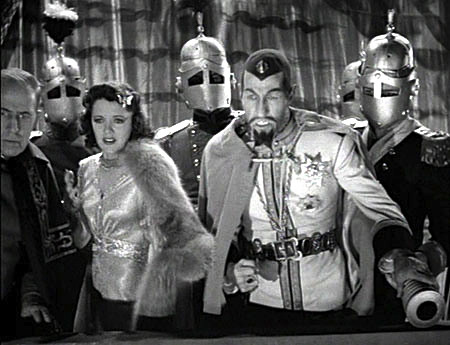


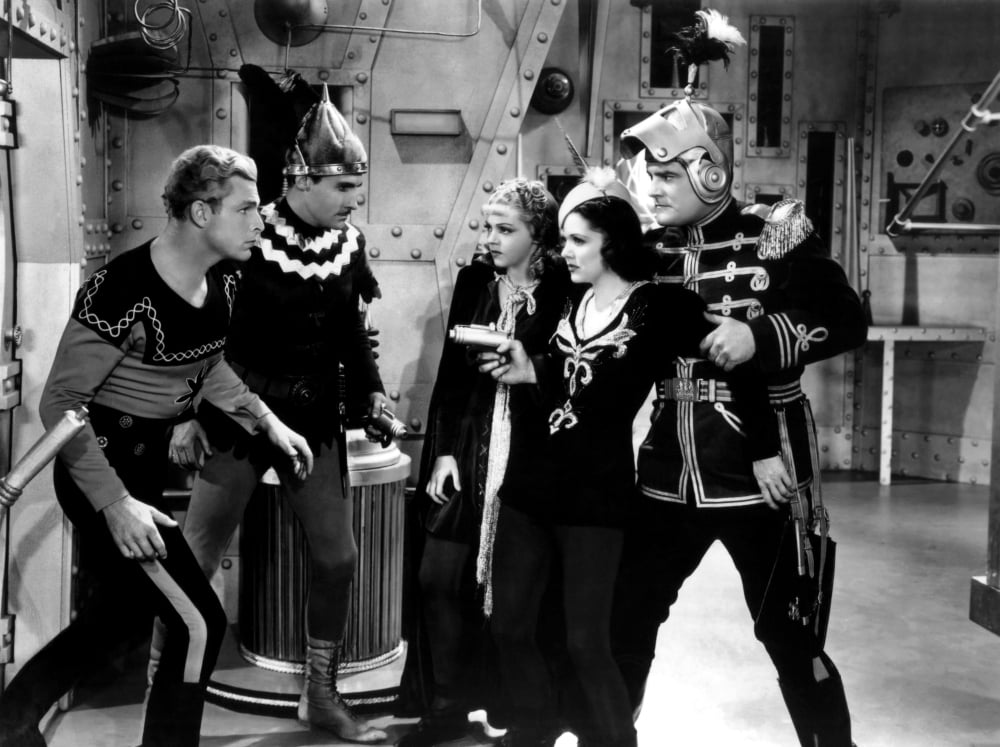
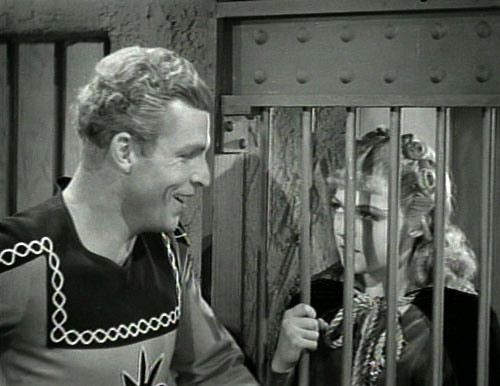
"Ming" and his most fanatic followers are betrayed by members of his guard and locked away in the high tower of his castle. What is unknown to both factions is that "Flash" is heading toward the castle in a rocket ship loaded with the high explosive "Solarite". "Flash" jumps from his rocket ship to "Prince Barin's" and rejoins "Barin", "Dale" and "Zarkov" as the flying bomb hits the castle tower.
The final words spoken by "Ming" to "Flash" were:
I AM THE UNIVERSE!"Dr. Zarkov" later mentions that:
FLASH GORDON HAS CONQUERED THE UNIVERSE!
As with the two previous serials, this one came to 1954 television as "Space Soldiers Conquer the Universe". In 1966 the serial was split into two feature films. The first six chapters became the "Purple Death from Outer Space" ending with "Flash" saving the planet and rescuing "Dale" and "Dr. Zarkov". The next six chapters were reworked into a feature film "Perils from the Planet Mongo".
"Flash Gordon" may have conquered "The Universe", but Adolph Hitler, not "Ming the Merciless" was seemingly conquering Europe and holding the United Kingdom at bey. Hitler banned the German edition of "Flash Gordon", while in Italy, Mussolini would only allow two-newspapers to carry the Italian translation. In England there was no censorship and the "King Feature's International" British version of the strip continued to entertain. While on, August 1, 1944, Hitler's Nazi forces found themselves facing the "Armia Krakow (Home Army)" in Poland. This standoff was known as the "Warsaw Uprising" aka: "The August Uprising" aka: "Battle of Warsaw". I bring this up because of the following photograph:
Above, a young corporal, in the Polish "Home Front" army, during the "Warsaw Uprising". Finds time to read a Polish language edition of one of the "Big Little Books", "Błysk Gordon - Królowa Błękitnej Magii (Flash Gordon - Queen of Blue Magic)" aka: "Flash Gordon and the Witch Queen of Mongo".
On May 8, 1945, Nazi Germany surrendered to the allies, on September 2, 1945, Japan surrendered to the allies, the Second World War had finally ended.
In the world of my youth there was another television network. The "Dumont Television Network", made its first broadcast on August 15, 1946, two-months before I was born. The independent network was holding it own against what was becoming the big two, the "National Broadcasting Company (NBC)" and the "Columbia Broadcasting System (CBS)". However, on April 19, 1948, the "American Broadcasting Company (ABC)" first appeared. It became fiscally impossible to have four active television networks during the first half of the 1950's, and the "Dumont Network" went dark over the loss of funding, on August 6, 1956.
One of the programs, from the "Dumont Network", that thrilled 7-years-old Lloyd, is mentioned in my article "Boldly Going Before Kirk and Spock: 1950's TV Science Fiction" blasting off at:
https://www.bewaretheblog.com/2015/12/boldly-going-before-kirk-and-spock.html
FLASH GORDON the program was first seen on October 1, 1954
A little political backstory, after the end of the Second World War, Germany was split in half by the "Victors". One half going to the Soviet Union, the other half to the rest of the allies.
A two part problem was created:
First problem:
The capital city of Germany was still Berlin, but the city was also split into sections, creating the Soviet Union controlled East Berlin, and the allied controlled West Berlin.
Second problem:
The city was located in East Germany! Which translated into needing Soviet Union approval to travel over, or through the heavily guarded East Germany to get to West Berlin.
By 1953, "Universal Pictures", now "Universal International", had let their film rights expire from the "King Features Syndicate" for "Flash Gordon". American Independent producers Edward Gruskin and Matthew "Matty" Fox approached "King Features" wanting to make a live-action, "Flash Gordon", television series and received authorization.
Next, realizing this didn't have the funding required, the two American producers made deals with two foreign production companies, one in West Germany, "Intercontinental Television Films", one in France, "La Telediffusion".
The television series would be filmed mainly in West Berlin, with a German film crew, and around the oldest city in France, Marseilles, with a French film crew. There would be 39-episodes, and the following link from the website "IMDb" describes all 39.
https://www.imdb.com/title/tt0140738/episodes/?ref_=tt_ov_epl
The Four Leading Actors:
Steve Holland portrayed "Flash Gordon". Holland was a model for "Fawcett Comics's" character of "B" Cowboy "Bob Colt", seen below, Steve Holland on the cover of "Issue #1" of "Bob Colt", November 1950.
Above, Holland portraying "Flash Gordon". Between 1951 and 1964, his total on-screen roles were 8, including portraying "Flash Gordon". Steve Holland is listed as appearing in only 31 of the 39-episodes of "Flash Gordon". In 1964, artist James Bama used Holland, below, as his model for 62-covers of reprint's of the "Doc Savage: Man of Bronze" novels.
Irene Champlin portrayed "Dale Arden". The actress only appeared in 6-different roles, all on television between 1953 and 1956. Like Holland, she is listed as appearing in only 31-episodes of "Flash Gordon".
In Vincent Terrace's, 2002, "Crime Fighting Heroes of Television: Over 10,000 Facts from 151 Shows", he writes that Champlin's "Dale Arden" wasn't the typical "Damsel in distress" as both Jean Rodgers and Carol Hughes where, but the character is a trained scientist, and a:
quick thinker who often saved Flash and Dr. Zarkov from perishing.
Joseph "Joe" Nash portrayed "Dr. Hans Zarkov". Who this Joseph Nash was, remains a mystery, because there appears to be no biographical information on him. Nash is listed as appearing in only 31-episodes of "Flash Gordon".
Between 1951 and 1955, he had only 3-acting roles. His second was on Buster Crabbe's 1955, "Captain Gallant of the Foreign Legion". I found a Joseph Nash, but I'm not sure if this is the same person. He appeared on Broadway as a "Dancer" in the 1946 revival of "Show Boat", and again as a dancer in the off-Broadway, 1956, "Carmen Jones", as a "Dancing Boxer".
Henry Beckman portrayed "Commander Richards". Beckman was a Nova Scotia, born Canadian stage actor, and compared to his co-stars on "Flash Gordon", between 1950 and 2002, the actor had 215-different roles. For this series he is listed as only appearing in only 8-episodes of the 39.
His character gives "Flash", "Dale", and "Zarkov", their orders from the "Galactic Bureau of Investigation".
One of the programs director's, American Wallace Worsley, Jr. is quoted by Wheeler Winston Dixon, in his 2008, "Tomorrowland TV: The Space Opera and Early Science Fiction Television"
No matter what galaxy we explored, everyone spoke with a German accent. The use of German actors who could not speak English required us to use a lot of close-ups. I would stand behind the camera, correctly positioned for the actor's look, and read his or her line; the actor would then repeat the line, mimicking my pronunciation and emphasis.
Filming on a sound stage in West Berlin was out of the question. The producer's found an abandoned beer hall, in the borough of Spandau, to use as their West German sound stage throughout the production.
As far as outdoor shooting, American's were shocked to see that 9-years after the Nazi surrender, even the allied portion of Berlin, still showed the signs of allied bombings. As Wheeler Winston Dixon wrote:
the copious stock footage and the numerous exterior sequences shot in the ruins of the bombed-out metropolis give Flash Gordon a distinctly ravaged look
The television program takes place in the year 3203. "Flash", "Dale", and "Zarkov" are investigators for the above mentioned, "Galactic Bureau of Investigation", and take their rocket ship, "The Sky Flash", on mission's given to the three from "Commander Richards".
Dixon in his work, mentions British cultural and architectural historian Mark Baker:
who wrote of a particular scene from the episode "The Brain Machine" as emblematic of this cultural split. The scene used stock footage of a June 17, 1953, demonstration, East Berlin workers against the East German government. Soviet tanks opened fire on both demonstrators and bystanders, thus confirming East Germany's status as a Soviet puppet state in the minds of West Germans. American viewers, Baker speculated, were probably unaware of the iconic power in West Germany of the images of fleeing East Berliners, which were used to illustrate a panic on Neptune.
Below, actual photos of the demonstration and the Soviet Union tanks:
In both "Episode 20, The Witch of Neptune", and its related "Episode 21, The Brain Machine". The producers used stock footage for a very short sequence, overlaid by an atomic bomb blast, in "20" and repeated as a flashback in "21", of supposedly Neptunian citizens in panic.
The following link takes my reader to "The Witch of Neptune":
https://www.youtube.com/watch?v=pOaoGVJzCjg&list=PLESDrGLwFOLXPWEt1deLurEuWL4ErzQT4&index=11
The following link takes my reader to "The Brain Machine":
https://www.youtube.com/watch?v=Qq9Qd0tVKeQ&list=PLESDrGLwFOLXPWEt1deLurEuWL4ErzQT4&index=12
In 1974, an adult parody of the 1936, "Buster Crabbe Flash Gordon Serial", with a little side attack on "Republic Picture's Classic Robot", was released. The motion picture was "Rated X - Adults Only", later it was re-released as an "R - Restricted" motion picture, and today, it might be rated lower with the old "No One Younger Than 16" rating.
Not to worry, this review is kept as censored as possible. However, for those who want to see more, the original release runs 78-minutes, but the "Collector's Edition" has a running time of 90-minutes.
FLESH GORDON released July 26, 1974
To start, the motion picture was filmed in 1971, and in that year, among the technical crew were "USC" cinema students, some of whom I will mention. The film is considered "Soft Porn", but it was also nominated in 1975, for the prestigious science fiction literary "Hugo Award", for "Best Dramatic Presentation". The "Hugo Award" winner in that category was Mel Brooks's, "Young Frankenstein". This Howard Ziehm, Bill Osco, and Walter R. Cichy production has obtained "Cult Status".
Joseph Hudgins portrayed "Dr. Flexi Jerkoff", in his only film role. This is also the only information on Hudgins I could locate.
William Dennis Hunt billed as William Hunt portrayed "Emperor Wang the Perverted". Hunt's second on-screen appearance wasn't until 1990's, "Flesh Gordon Meets the Cosmic Cheerleaders". Which was followed by 47-non-porn motion picture and television roles through 2019.
An Outline of the Plot:
A plane carrying "Professor Gordon's" son and a young woman named "Dale Ardor" is hit by the ray and the crew and passengers go into uncontrollable sex. As a result the plane is going to crash and "Flesh" and "Dale" parachute to safety and find themselves by the phallic shaped rocket ship of "Dr. Jerkoff". The three leave for the planet "Porno" and the rest of the skin-play sort of follows the 1936 "Flash Gordon".
Above left to right, Mycle Brandy portraying "Prince Precious", Suzzane Fields portraying "Dale Ardor", Jason Williams portraying "Flesh Gordon", and Joseph Hudgins portraying "Dr. Flexi Jerkoff".
Next, Alex Raymond's creation moved from "Soft Porn", to "Soft Kid's Cartoon's". On Saturday morning's, from September 22, 1979 through November 6, 1982, the "National Broadcasting Company (NBC)", ran the "Filmation" animated series "The New Adventures of Flash Gordon", aka: "The Adventures of Flash Gordon".
It was back to live-action with "Additional Music" by Freddie Mercury, Roger Taylor, Brian May, and John Deacon, better known as the British rock group, "QUEEN".
FLASH GORDON released December 8, 1980
This filmed version of Alex Raymond's comic strip was produced by Dino De Laurentiis. Who had just produced 1979's, "Hurricane", starring Jason Robards, Mia Farrow, and Max Von Sydow, based upon the James Norman Hall and Charles Nordhoff's novel, they're the authors of the classic "Mutiny on the Bounty" trilogy.
Bernard Williams was executive producer, he had just produced the 1978 version of author Raymond Chandler's, "The Big Sleep", starring Robert Mitchum portraying "Phillip Marlowe".
Michael Allin had adapted Alex Raymond's comic strip into a story for a screenplay. He had just written the forgotten, 1980, "The Border", starring Telly Savalas,
Lorenzo Semple, Jr. wrote the actual screenplay. He was the screenplay writer for 1979's, "Hurricane". He had written the actual screenplay for De Laurentiis's, 1976, "King Kong".
The Seven Leading Actors:
Sam J. Jones portrayed "Flash Gordon", the name "Flash" is apparently the character's actual first name. This was Jones's third on-screen appearance, his second was a 1980 prosed pilot for a television series entitled "Stunts Unlimited", but was not picked up. In the "Marine Corps", Jones had played football. After his enlistment ended, he tried out for the "Seattle Seahawks", but did not make it. Next, Sam Jones became a professional model and appeared in "Playgirl". His role in the 1979 motion picture "10", led to this feature film. According to Mike Hodges, in his August 24, 2010 article, "Flash Gordon was a bumpy road - - - -", on the "Total Sci-Fi Online" website at:
The basically unknown Sam Jones, beat out both Kurt Russell, and Arnold Schwarzenegger for the role.
Melody Anderson portrayed "Dale Arden". Anderson had six-previous television appearances that included one episode each of "Welcome Back, Kotter", "Logan's Run", "B. J. and the Bear", and "Battlestar Galactica". Along with co-starring with singer Tom Jones in a 1979, made-for-television movie, "Pleasure Cove", a failed pilot for a proposed television series, and 7th-billing, in the 1979 made-for-television biography, directed by John Carpenter, "Elvis", starring Kurt Russell.
Max Von Sydow portrayed "The Emperor Ming". Swedish-French actor Von Sydow had a distinguished acting career. Three of his diversified starring roles were in Swedish director Ingmar Bergman's, 1957 classic, "The Seventh Seal", portraying "Jesus" in director George Stevens's, 1965, "The Greatest Story Ever Told", and of course, the title role of director William Friedkin's, 1973, "The Exorcist".

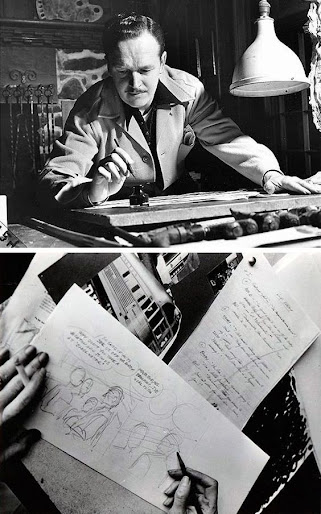





















_1.jpg)





_08.jpg)













_07.jpg)



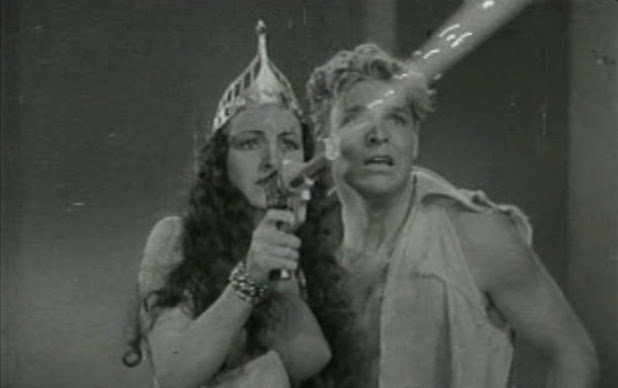





.png)










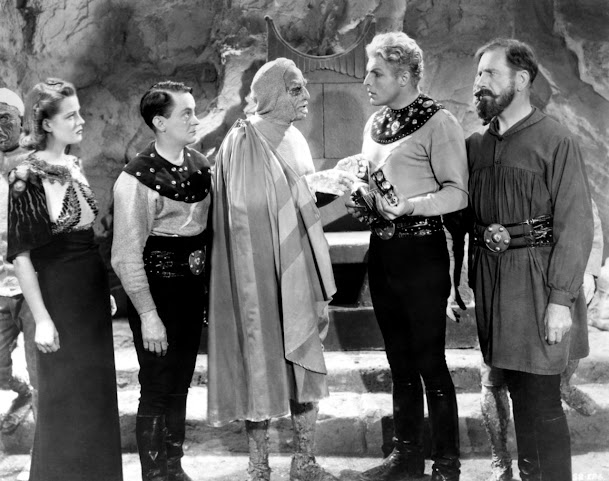









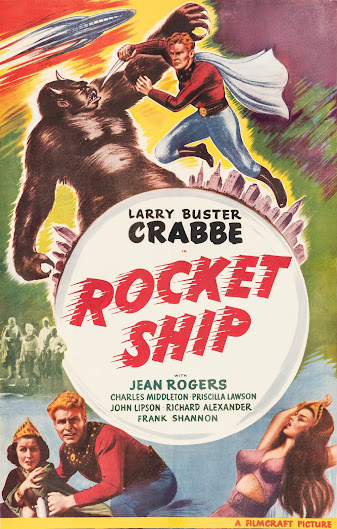















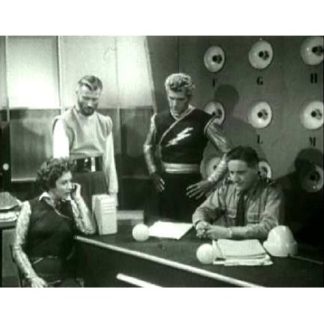









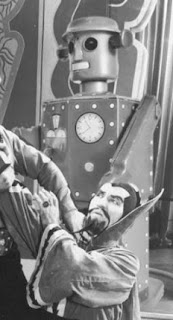


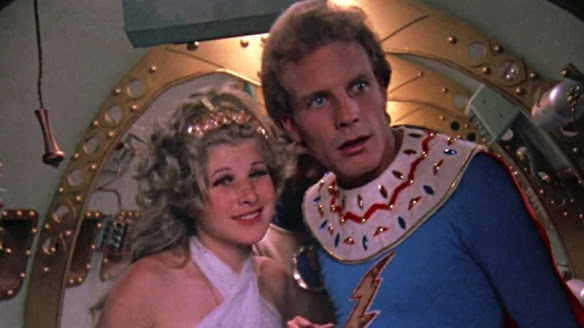








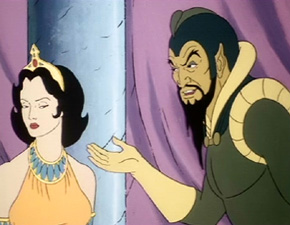





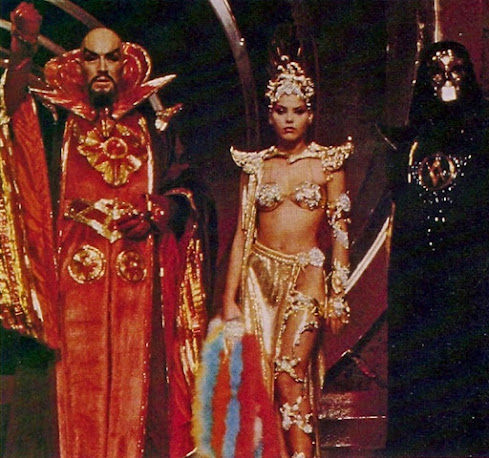












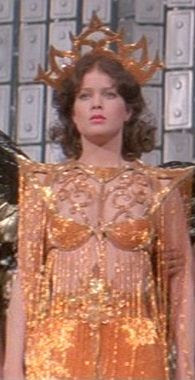









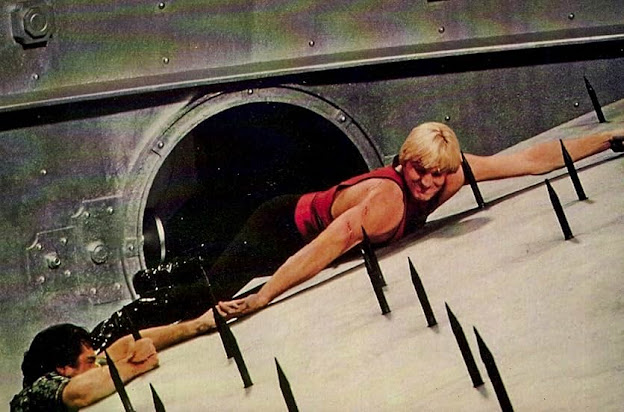







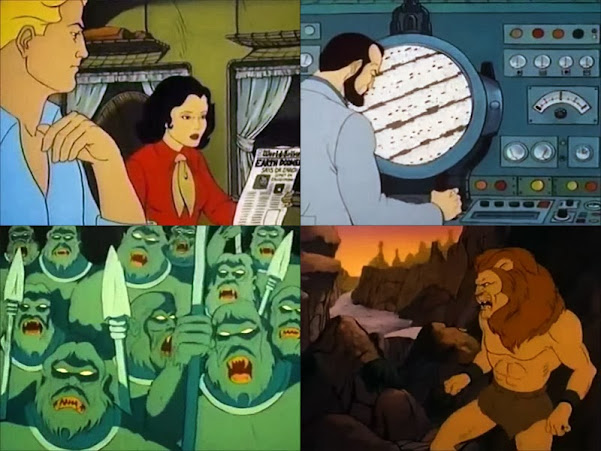
















No comments:
Post a Comment